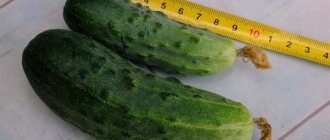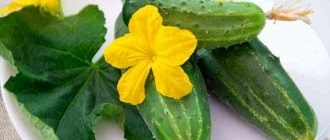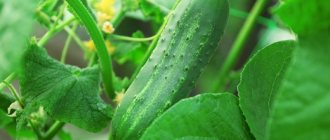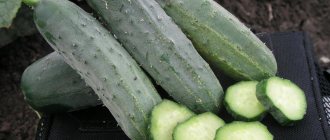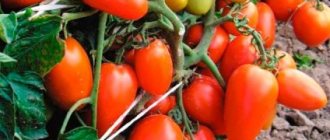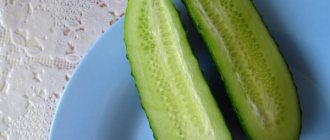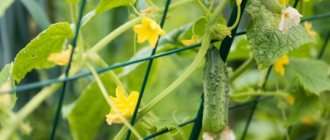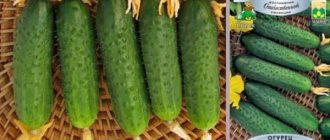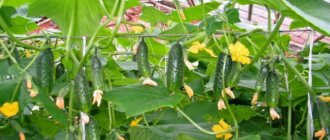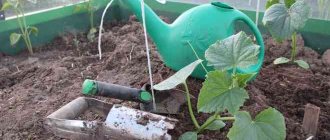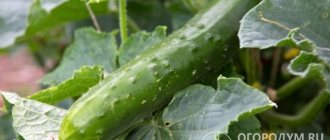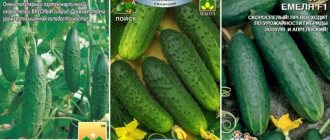City cucumber F1 was bred in 2008 by agro, the city of Mytishchi. Included in the state register of Russia for the Northern, Central, Northwestern, Central Black Earth, Volga-Vyatka, Middle Volga and North Caucasus regions. Manufacturers recommend growing it on balconies, loggias, verandas or directly on the windowsill. Suitable for both open and closed ground. Recommended for planting in central Russia and the North Caucasus region. For its ease of cultivation and unpretentiousness, it is very popular among our farmers.
Description of the variety
This is a hybrid variety, parthenocarpic, and therefore does not require pollination by beetles, bees or other insects. It consists exclusively of female flowers collected in inflorescences, which is why it also received the name bunched. Differs in early ripening. Shade-tolerant, easily tolerates short-term “drought”.
Description of the bush:
- The plant is distinguished by strong branching, tallness and densely covered with green leaves. Because of this density, the bush seems very large, but in reality this is not entirely true.
- All leaves are medium in size, and multiple ovaries are formed inside the axils.
- The number of buds can vary from 3 to 10 pieces.
The first green shoots are noticeable already on days 40-42 from the moment the sprouts appear.
Attention! The planting density in open ground is 4-5 plants per 1 m2, and in greenhouses – 2-3 per 1 m2.
The fruits of the hybrid are oval-cylindrical in shape and belong to the finger varieties with weakly defined ribs. There are visible bumps. On average, the weight of the fruit is 100 g, length - 10-12 cm, diameter - small - 3-5 cm. At the gherkin stage, the skin gradually acquires a bright green color with white stripes along the edges of the cucumber. Often unclearly expressed.
Advantages of City Cucumber F1:
- abundant yield;
- early ripening;
- drought resistance;
- resistance to some pests and diseases;
- self-pollinating;
- possibility of growing at home;
- fragrant, delicate taste;
- ease of cultivation.
Disadvantages: inability to collect seeds.
The pulp is juicy, without voids and bitterness with small white grains. The skin density is moderate. Small black spines with slight pubescence stretch along the entire surface. The stalks are long. Excellent for canning and pickling.
Consumer qualities
The fruits are small in size, gherkin type. The length of the greens at technical ripeness is no more than 12 cm; fruit diameter is 2-2.5 cm. Even overripe cucumbers do not become large and do not form hard seeds. It is recommended to collect greens daily: this promotes the growth of the following ovaries in the hand.
The skin of a young cucumber is not too dense and is practically not felt when eating the fruit. Nevertheless, it is quite strong, allowing cucumbers not to lose their elasticity and presentation for several days. Cucumbers are quite transportable; Store in the refrigerator for several days.
The color of the skin is green; at the tip there is a small light area, from which several parallel stripes of a yellowish-white hue extend to the base. There are not too many tubercles; As the fetus grows, they become rare and inconspicuous. The spines are white and blunt.
Growing at home
The quality of future cucumbers will directly depend on the amount of microelements, vitamins and sowing work. It is better to set the landing date for mid-May; it will take about a month.
In home growing conditions, seeds are placed in flowerpots, pots or special planting containers. Containers must have a double bottom, a tray or holes for draining water. The containers are pre-treated with a solution of calcium nitrate. This promotes the growth and development of the root system. The soil is prepared 50/50 from the mixture:
- loose humus;
- garden soil.
If you need to reduce the acidity, then for every 5 kg of the mixture add 1 tablespoon of eggshells or chalk. Instead, you can use complex fertilizers:
- Agricole;
- Kemira luxury.
At first, you can plant 2-3 seeds in one container, and transplant them into separate ones as they grow. The depth of the backlog should not exceed 2 cm.
The suitable period for landing is from May 1 to 5 on a closed balcony, from 10 to 15 on an open one. At the time of transplantation, the seedlings should be at least 10-15 days old. Correct garter technique is the key to successful growth. The support will be a twine, which is attached to the top of the balcony, and special supports in the pot.
Planting and care in open ground
For this type of planting, the presence of “insulated” soil is important, so first lay a layer of compost or manure, and then fertile soil. During the decomposition of biofuel, heat is released, which warms the soil.
Note!
You can plant using a trellis method, then up to the first 5 leaves, all ovaries and side shoots are removed. At the next three nodes, only bunches of ovaries are left.
When the seedling reaches 120-130 cm, no more than two bunches of ovary are left on the side shoots, and then be sure to pinch them off. A month before the end of the season, it is advisable to pinch the top of the central vine. Then the cucumbers will grow on the formed bunches. You can pinch the main stem at a distance of 3-4 leaves, and lead the bush in 2-3 loops.
Before sowing, the seeds can be germinated a little. To do this they need:
- place in a damp cloth (preferably gauze);
- leave in a warm place (+28-30 °C) for 1-2 days.
Plant the sprouted grains one at a time in a five-liter tray.
Care
When the first shoots become noticeable, the daytime temperature should be +20-25 oC, and the night temperature – +18-20. This will help prevent the greens from being pulled out. It is highly undesirable to use small flowerpots. The soil will often dry out, and the root system will not have time to wrap around much of the substrate. This can greatly harm the plant.
Recommendations:
- Water regularly with warm water. To keep moisture in the soil longer, you can use a hydrogel. These are granules that accumulate water. When the roots grow and penetrate the granules, they receive a sufficient amount of water and microelements.
- Thinning and hilling will also help produce a large, healthy crop. Hilling up ensures better absorption of moisture after watering and accelerates the growth of the root system.
For hybrid cucumbers, feeding is very important. If you don’t want to buy fertilizers, you can try making them yourself.
Wood ash - it contains many useful substances that contribute to the formation of the fruit. It can be used dry or made into an infusion.
You may be interested in: Favorable days for transplanting cucumbers in open ground Dates for planting cucumbers in May 2021 according to the lunar calendar The most favorable days for planting cucumbers in the Leningrad region according to the calendar of gardeners and gardeners
- Dry ash is sprinkled on the ground before watering.
- For the infusion you will need 1 liter of water and 3 tablespoons of ash. The solution needs to infuse for 2 weeks.
Yeast - usually the solution is prepared from one pack and 10 liters of water. Dissolve the yeast in water and keep in a warm place for 3 days. The fertilizer needs to be mixed once or twice daily. The solution is applied after watering the cucumbers. Usually it takes 0.5 liters per bush, but you shouldn’t abuse it. The number of treatments should be no more than two to three times per season.
Chicken manure - this fertilizer contains the following substances:
- manganese;
- zinc;
- cobalt;
- iron, etc.
They can be used to feed not only cucumbers, but also other crops. To prepare the infusion you will need organic matter and clean water (1:20). It takes several hours to stand.
Attention!
It is recommended to use this fertilizer no more than three times per season.
Bread - a loaf is soaked in water and left for a day. In the morning, knead the bread and add 10 ml of iodine. Proportions: 1 liter of fertilizer per 10 liters of water.
Soil, nutrition, lighting, watering - how FORUMHOUSE users get winter cucumber harvests.
Getting a winter harvest of cucumbers “from your windowsill” is not so difficult. We will tell you what difficulties may be encountered along the way, and how FORUMHOUSE participants cope with them.
If you sow the seeds in October, the first harvest will be harvested in time for the new year. December sowing will yield a harvest in February, and cucumbers sown during the New Year holidays will ripen by March 8th.
Indoor cucumbers are grown in loose soil (you can buy ready-made, you can mix 1:1 humus and garden soil), with the addition of wood ash and potassium-phosphorus fertilizers. Fertilizers are an important point in growing indoor cucumbers, since, as you know, this crop generally “loves to eat.”
It’s good if you have vermicompost – you can add a liter of vermiculite to three liters of prepared soil. Before sowing, the seeds are disinfected and germinated. It is not recommended to be greedy - two packets of seeds will yield 20 cucumber bushes. First, it is better to sow the seeds in individual seedling cups (care for the seedlings as usual), and after the appearance of the third true leaf, plant them in permanent containers.
Cucumbers planted on January 25 fruited for four months from March.
FORUMHOUSE member SanSanych58 has been making balls of water-soluble fertilizers, such as mortar, for 10 years, and placing them at the bottom of the pot. There are three grams of fertilizer per liter of soil, so an eight-liter pot requires 24 grams of fertilizer, or four six-gram balls. So, six grams of mortar is wrapped in a 10x10 cm piece of cling film, rolled into a ball, the tail of the ball is folded in half and grabbed with tape so that it does not unfold. Each ball is pierced with a thin needle and placed in the soil 1/3 of the depth of the pot, pierced down.
For convinced opponents of any “chemistry”, there is a wonderful recipe for organic feeding: a handful of orange peels is poured with boiling water and left for 3-5 days, until the active work of lactic bacteria begins (we will know about it by the appearance of bubbles). Dilute with water 1:3 and water. If you add nettle infusion, the plant will receive both nitrogen and a full set of microelements.
The most difficult thing about growing indoor cucumbers is that it is almost impossible to provide the level of humidity they require. If the room is heated by a radiator around the clock, then even humidifiers will not radically change the situation. But the desire to pick your own cucumber in the middle of winter, without nitrates and other nasty things, forces users of our portal to overcome any difficulties.
There is this method: a large vessel with water is placed under the battery, a blanket is placed on the battery, and the lower end of the blanket is lowered into the water. Empirically, a bedspread is selected so that it does not have time to dry out.
As the water evaporates, it is necessary to add water into a large vessel, the role of which is usually a baby bath, and wash the bedspread from time to time. This method is truly effective, but few people are satisfied with its aesthetic side.
It is best to water cucumbers with warm water, the temperature should be slightly warmer than room temperature. Alternatively, you can heat melt water on a radiator.
My eggplant sits in a tray with water or a nutrient solution, and the cucumber drinks as much as it wants. I add water or nutrient solution every day. And every day I pick one large or small cucumber.
The more often we harvest, the longer our window sill cucumber will live. Ideally, cucumbers should be picked every day.
Related article: Do-it-yourself warm window sill
When growing cucumbers in the garden, we always mulch them, but when we grow them on the windowsill, we often forget about this technique. But it is better to mulch, because the roots of this plant are very close to the surface of the soil. It is better not to put mulch close to the stem, leave a distance of 5-7 cm.
As for light, it is not as important for cucumbers as, for example, for tomatoes.
Cucumbers generally require more soil than tomatoes and less sun.
That is, cucumbers are a light-loving crop, and for normal growing season they require 10 hours of light per day, and, most likely, they will have to organize lighting, but:
Moreover, they do not like direct sun in indoor conditions, where the air is almost motionless, plants evaporate moisture very poorly and can easily overheat (a visual sign of plant overheating is drooping leaves). Therefore, cucumbers will have to be shaded, especially on the southern windowsill. A piece of any transparent fabric, such as an old curtain, which is secured between the plant and the window glass, will do. Cucumber leaves should not touch the glass - this can cause burns!
These plants respond to aridity and heat by dropping cucumbers that have already set. And it's so offensive!
The cucumber has already responded to the aridity and heat - it has dropped 14 cucumber ovaries in a row.
Therefore, many FORUMHOUSE users try to create a special microclimate for plants. So, Sly Fox has cucumbers on the windowsill, where:
- the lower part of the window is sealed with film;
- an 18 W phytolamp hangs above the cucumbers; as the cucumbers grow, the height of the lamp is adjusted;
- cucumber beds are separated from the room by a tulle curtain;
- Since the room is heated by a stove, the plants are sprayed with water daily.
What surprised me was that even such a “holey” material as tulle allows you to create your own microclimate on the windowsill.
Another problem with cucumbers is that when grown on a windowsill, they often produce a huge number of male seeds and almost no female ones. This often occurs due to fresh seeds.
In addition, it is recommended to warm cucumber seeds before sowing - this technique stimulates the formation of female flowers.
Female flowers may not form even if the plant is undernourished. Feeding with phosphorus fertilizers will help us here: 60-70 g of superphosphate extract per 10 liters of water.
And in order to provoke the growth of fruits along the main stem, female flowers (with ovaries) are removed from the lower two internodes. In the photo below we see four internodes; the female flowers of the lower two need to be removed. In the photograph, this is the one that is aimed at us and the one that is visible behind the stem.
For growing indoors, you should choose shade-tolerant varieties that do not require pollination. Among these varieties, according to the experience of FORUMHOUSE users, the following proved to be the best: Berendey F1, Zozulya F1, Gribovsky-2 F1, Rytova (Russian agrobiologist Mikhail Rytov bred the first cucumbers for growing indoors), Room F1, Emerald Potok A1.
Suitable for growing on balconies: City Cucumber F1, Balagan F1, Calendar F1, Hummingbird F1, Swallowtail F1.
Today I removed about 5 kg of cucumbers from my window. Of these, one bush is Emerald Flow - 2.3 kg (9 greens, weight from 180 to 345 g), the rest are Cadet, Rais and Dynamite.
Keep in mind, however, that your indoor cucumbers will never be as small and compact as seed manufacturers promise. Add another ten and a half centimeters to the length of the lash that you are promised on the packages - due to the lack of sun, the plants will most likely stretch out.
Diseases and pests
It is noted that cucumbers of this variety are resistant to diseases such as downy mildew, brown spot and powdery mildew. But there is always a small risk of infection, so be prepared for it.
Other possible diseases may include ascochyta blight. This disease attacks both seedlings and adult plants. Seedlings located in greenhouses and open ground can get sick. It is most active during the fruiting period. Signs: the edges of the leaves become covered with gray spots, which, over time, spread over the entire leaf area. Small white-brown spots form on shoots, leaves or stems. Gradually, the fruits turn black or become covered with black dots. Control measures:
- avoid temperature changes;
- disinfestation of greenhouses and seeds;
- spraying Bordeaux mixture (1%);
- treating the stem with a copper-chalk solution.
Bacteriosis spreads in a humid, warm environment. Rains followed by heat provoke disease activity, which can result in the death of 60%-70% of the crop. At the last stage, necrotic spots appear, after which the plant can no longer be saved. Signs: the appearance of brown oily spots that gradually increase in size. Localization: any parts of the plant (leaves, fruits, flowers). The greatest activity occurs during the growing season. Transmitted through infected seeds. Often develops in greenhouses. Control measures:
- disinfestation of frames and greenhouse frames;
- ventilation;
- humidity level control;
- treatment for necrosis with special preparations.
Root rot - the main cause is increased soil moisture. As a result, the root system weakens and becomes very sensitive. Another reason may be a high concentration of salts in the soil. Signs: the stem becomes thinner and dries out quickly. After digging, characteristic spots are visible - burns. The root darkens and the leaves die. Control measures:
- regular mail updates (every season);
- moisturizing with warm water;
- elimination of infected plants;
- treatment with bleach;
- loosening.
Pests can attack greens both in open ground and at home. The most common are: spider mites, aphids, and whiteflies.
Spider mites are very heat-loving, preferring greenhouses and greenhouses. Located at the bottom of the foliage. The main symptom is the appearance of cobwebs. Gradually the leaves begin to dry out and die. Control measures:
- maintaining optimal humidity levels;
- treatment with a solution of laundry soap;
- watering, spraying;
- use of insecticides.
Aphids have a high reproduction rate. The parasite is difficult to detect; its body is only 2 mm long.
Note!
Aphids attack young shoots. The peak of activity occurs at the beginning of spring. Immature plants are at risk.
Fighting methods:
- ablution with water pressure;
- soap solution;
- tobacco solution;
- destruction of anthills;
- whitewashing plant trunks;
- “Tanrek”, “Aktara” are proven drugs.
Whitefly infects the leaf blade. Leads to its yellowing and death. The cause may be high humidity or lack of ventilation. Whitefly larvae can be seen on the back of the leaf. They are usually small and inactive. When a waxy coating is visible from above, they are no longer afraid of insecticides and treatments. Control measures:
- quarantine;
- disinfestation of greenhouses and seeds;
- soil disinfection;
- weed removal;
- sticky fly tapes.
The yield of the variety is, on average, 10-12 kg per 1m2. The good thing about this variety is that most cucumbers are marketable. The shelf life is 2-3 weeks. Dryness will help preserve greens for up to a month.
Hybrid "Urban cucumber f1": harvest of cucumbers on the windowsill
The hybrid "City Cucumber F1" was bred by agro. If you don’t have a summer cottage, this variety can be grown at home - on balconies, verandas and even windowsills. According to the description and reviews, it is characterized by: small size, the ability to bear fruit in difficult conditions and high yield.
- General characteristics of the hybrid
- Growing
- Pests and diseases
- Reviews
General characteristics of the hybrid
It is a highly branched plant with long vines and small leaves. In closed conditions, it is best to form it into one stem; in garden beds you can grow several vines from 1 root.
The hybrid does not need insects to pollinate its female flowers (parthenocarpic). It has bunched ovaries. 40-41 days after germination, the first fruits can be harvested. According to the manufacturer's description, on average from 1 sq.
m you can collect 10-12 kg of vegetables, from one bush up to 3.5 kg.
Other advantages of the “City Cucumber F1” variety:
- stress-resistant;
- shade-tolerant;
- early ripening;
- long fruiting;
- resistance to common diseases (powdery mildew, cucumber mosaic);
- marketable condition.
The fruits are small, oval-cylindrical in shape, gherkin-type - up to 12 cm in length, diameter - up to 2.5 cm. Even if the vegetables are not collected on time, they do not outgrow. The weight of the cucumber is 75-90 g. The skin is strong, but thin.
When used in food, it is not felt, but does not allow cucumbers to lose their elasticity. The color of the skin is bright green, with white stripes. Greens with tubercles, white-thorned. The inside of the cucumber is greenish, the fruit itself is crispy.
Growing
Before sowing, you can germinate the seeds by wrapping them in a damp cloth and placing them in a ziplock bag for 2 days in a warm place. The soil should be humus, free-flowing and breathable.
When growing cucumbers in containers, it is best to add an organic amendment to the soil mixture before planting.
Organic soil amendments provide not only nutrients, but also endomycorrhizae.
Endomycorrhizae create a thin, fibrous root structure that envelops every particle of soil. They form a moisture-retaining, nutrient network that reduces the need for watering and creates healthy bushes.
For cucumbers to develop, use organic fertilizer every week, containing potassium, phosphorus and magnesium, but without nitrogen. The hatched seeds are planted approximately 1 cm deep into the soil in a container with a capacity of at least 5 liters per plant. Additionally, the container must be equipped with a tray. Watering should be regular to keep them constantly moist. In 10 days the seedlings will germinate.
The average temperature for growing this variety is 25 C. In the beds, plants bear fruit at a temperature of 15 C and above at night, 24 C during the day. Air humidity on balconies and verandas is kept at 70%. The recommended planting density for cucumbers in open ground is 5 plants per 1 square meter. m, indoors - 2-3.
When the plant reaches a height of 2 m, it is recommended to pinch the top. After this, the cucumber will produce side shoots with a large amount of ovary. "City cucumber F1" is very spreading, and therefore needs to be tied up in closed conditions. A good solution is horizontal trellises. Advantages of growing cucumbers on a trellis:
- this will prevent the foliage from getting wet, which will help avoid fungal infections;
- saving space on the site;
- air circulation;
- easy to control pests;
- easier to collect fruits;
- fewer misshapen cucumbers.
In the last month of the season, the top of the middle vine is pinched so that the vegetables grow on the already formed bunches. When growing in beds, you can pinch the main stem above 3-4 leaves and then grow the bush in 2-3 vines. The plant can bear fruit until frost.
It is recommended to cover new seedlings with garden fabric or covers until they begin to sprout.
Pests and diseases
Balcony cucumbers are sensitive to a couple of pests: spider mites and thrips. They are an almost invisible pest early on, but can be destructive as their numbers increase.
Adult thrips are tiny winged insects. Nymphs do most of the damage by congregating on the undersides of leaves and sucking plant juices.
Plant leaf diseases often occur in damaged tissue caused by thrips.
Spider mites are tiny red mites that gather on the webs covering leaves. Like thrips, they cause damage by sucking nutrients from leaves. These pests can be controlled using soap sprays.
Powdery mildew looks like a white powder sprinkled on the surface of leaves. Infection occurs at high humidity and when plants are under stress. Ensuring good air circulation helps prevent this. If signs of disease are noticed, remove all severely affected leaves. You can get rid of it by choosing 1 of 2 home recipes:
- Mix 1 teaspoon of baking soda with 1 drop of dish soap and 1 liter of water and spray on the plants. This raises the surface pH of the leaves, making them less attractive to spores.
- Mix 1 part cow's milk with 9 parts water and use the mixture as a foliar spray every time it rains. Enzymes in milk prevent the development of fungus.
A characteristic feature of cucumber mosaic is a pattern of spots or lines on the leaves and fruits. The patterns on the leaves are deformed and may be white, yellow or light to dark green. Their veins become distinct.
When infected with cucumber mosaic, the plant begins to bear fewer fruits, and small and ugly ones appear more often.
There are currently no treatments that can cure or prevent cucumber mosaic virus infection. Prevention is the only way to prevent or get rid of viral plant infections.
Remove all infected plants and plant materials. Garden tools and clothing are often disinfected. Insecticides containing carbaryl and methoxychlor are sprayed to help control pest populations.
Use a homemade spray made from crushed garlic and soapy water to kill aphids.
Reviews
Arkady:
'City Cucumber F1' was chosen along with other hybrids due to its tall vines. I raised the seedlings indoors and planted them out after May 20th. The whip was tied to an inclined portable grate. I have been growing these cucumbers for many years, they have fewer diseases, and I ventilate them well. They were fed once with the “Ideal” preparation, then with plant extract and yeast. The bush bore fruit throughout the summer.
Svetlana
The main difference between these gherkins is their compact size. However, this does not affect the excellent taste characteristics. Vegetables remain crisp even after salting and canning.
On the balcony, the cucumbers stood on the south side, right in front of the balcony railings and eventually entwined them. This prevented the plants from dropping when they began to bear fruit.
Regularly watered with warm water and fertilized at least 2 times every 7 days.
Unfavorable location and improper care contribute to the development of diseases and pests.
Therefore, the following points must be observed: a minimum distance of 20 cm or plant one plant in a container of at least 5 liters. No matter how thirsty your plants may be, you shouldn’t overdo it.
The area should be protected from drafts and the floor should be free of germs. If the substrate is contaminated, it must be discarded.
Source: https://zelenj.ru/gibrid-gorodskoj-ogurchik-f1.html
